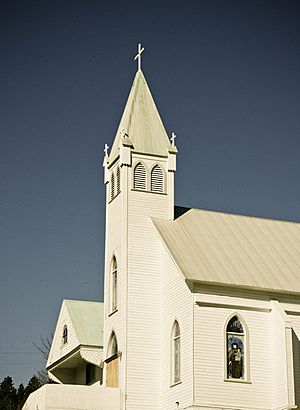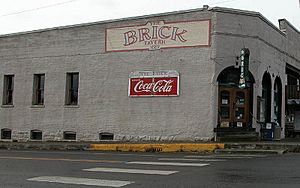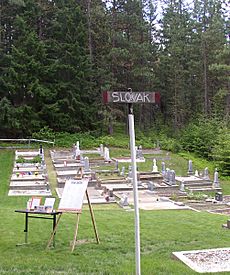Roslyn, Washington facts for kids
Quick facts for kids
Roslyn, Washington
|
|
|---|---|
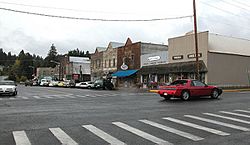
Downtown Roslyn
|
|
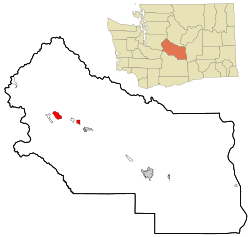
Location of Roslyn, Washington
|
|
| Country | United States |
| State | Washington |
| County | Kittitas |
| Area | |
| • Total | 4.39 sq mi (11.37 km2) |
| • Land | 4.39 sq mi (11.37 km2) |
| • Water | 0.00 sq mi (0.00 km2) |
| Elevation | 2,247 ft (685 m) |
| Population
(2020)
|
|
| • Total | 950 |
| • Density | 216.4/sq mi (83.6/km2) |
| Time zone | UTC-8 (Pacific (PST)) |
| • Summer (DST) | UTC-7 (PDT) |
| ZIP code |
98941
|
| Area code(s) | 509 |
| FIPS code | 53-60055 |
| GNIS feature ID | 1525216 |
| Website | City of Roslyn |
Roslyn is a small city in Kittitas County, Washington, United States. In 2020, about 950 people lived there. Roslyn is nestled in the beautiful Cascade Mountains, about 80 miles (129 km) east of Seattle.
The town started in 1886 as a company town for coal mining. Over time, it moved away from coal. Today, its main activities are forestry (managing forests) and tourism. Roslyn is famous for being a filming location for TV shows like Northern Exposure. Many of its old buildings are still standing, and its downtown area was added to the National Register of Historic Places in 1978.
Contents
Roslyn's History
How Roslyn Began
People first found coal in the Roslyn area in 1883. A big coal deposit was discovered in 1885. Roslyn was officially planned out in 1886 by Logan M. Bullet. He was a leader at the Northern Pacific Coal Company, which started the first coal mining operations there. The coal was needed to power trains.
The Northern Pacific Railway was building tracks across the Cascade Mountains to reach Puget Sound. A long tunnel was built under Stampede Pass, near Roslyn. Roslyn's coal helped build the railway and kept the trains running.
Immigrants and Mining Life
From 1886 to 1929, many immigrant workers came to Roslyn to work in the mines. They came from countries like Italy, Poland, Slovakia, Germany, Lithuania, Slovenia, Serbia, Croatia, England, Ireland, Scotland, and Wales. These families kept their traditions alive. You can see this in the Roslyn Historical Cemeteries, which have 26 different sections for various ethnic and community groups. Many people living in Roslyn today are descendants of these brave miners.
In 1892, a sad event happened: 45 miners died in an explosion at Mine No. 1. This was the worst mining accident in Washington's history.
The End of Coal Mining
Roslyn produced the most coal in 1910, nearly 2 million tons. But as trains started using diesel instead of coal, the mines began to close in the 1920s. Even though there was still a lot of coal left, the last mine in the area closed in 1963 because it was no longer profitable. Many people left Roslyn when the jobs disappeared.
However, in the mid-1970s, Roslyn started to become popular again. Artists and other people began to fix up the old houses and shops. Some people who work in Seattle or Tacoma now have second homes in Roslyn.
Life in a Company Town
Roslyn was a "company town". This meant that the Northern Pacific Coal Company owned most things and controlled daily life. Most people worked for the company or for small businesses it controlled. A very important place was the Northwestern Improvement Company Store. It's now on the National Register of Historic Places and still stands today.
In 1888, a big fire destroyed most of Roslyn's downtown. After the fire, many new buildings were made with fire-resistant brick and sandstone. Some of these old buildings are still used, like the 1889 Brick Tavern.
The Northern Pacific Coal Company also built the Roslyn Athletic Club in 1902 for miners and their families. It had a gym, meeting rooms, and a bowling alley. Roslyn's public library, started in 1898, moved into this building in 1918 and is still there.
Most of the town's 500 homes were built in the 1920s. The downtown area had many commercial buildings, and about a dozen of them still show what western frontier architecture looked like. Roslyn has beautiful Victorian buildings and simple miner's shacks. The town was added to the National Register of Historic Places in 1978.
Today, the old railroad tracks have been removed and turned into the Coal Mines Trail. This trail goes from Cle Elum through Roslyn to Ronald. You can walk on it and see what's left of the mines and the old train station. The Roslyn Museum has many photos and items from the mining days, and it has a special exhibit about Roslyn's unique cemeteries.
Recently, fun activities and tourism have become the main ways Roslyn makes money. The town holds yearly festivals, like the Manly Man Festival in June and a Coal Mining Festival in August, to attract visitors.
African American Community in Roslyn
In 1888, there was a labor strike by workers in the Roslyn mines. The mining company brought in new workers, including about 50 African American laborers from the East and Midwest. More than 300 African American workers and their families moved to Roslyn over the next two years. This was the largest increase in the African American population in Washington Territory at that time.
At first, there were some tensions, but eventually, white and Black miners worked together. As the coal industry grew, workers organized into unions like the United Mine Workers.
In 1890, about 22% of Roslyn's population was African American, which was one of the highest percentages in the state. Black community groups and churches were formed, like the Prince Hall Masons and the African Methodist Episcopal Church.
After the mines closed in 1963, the Black population in Roslyn began to shrink. By the early 1970s, only the Craven family remained. William Craven became mayor of Roslyn in 1976, making him the first African American mayor in Washington state.
The Roslyn Black Pioneers organization was started by Ethel Florence Craven to help save and share Black history in Washington.
Roslyn's Unique Cemeteries
The Roslyn Cemetery is very special because it has 26 separate burial areas, all next to each other. This shows how many different groups of immigrants lived in Roslyn. It was added to the National Register of Historic Places in 1978.
These areas were given or sold by the Northern Pacific Company to various community and ethnic groups. They used them to bury their members. Groups like the Independent Order of Odd Fellows, Knights of Pythias, and many Italian, Croatian, Serbian, and Greek Catholic lodges have sections here. There are almost 5,000 graves, representing at least 24 different nationalities.
Roslyn Today: Tourism and Recreation
While Roslyn still remembers its coal mining past, it has become a popular place for tourists and outdoor activities. Being a filming location for movies like The Runner Stumbles and TV shows like Northern Exposure helped bring more visitors. Because it's close to Seattle, many people come to Roslyn for recreation.
New luxury homes are being built nearby in a community called Suncadia. This area includes a large golf course community with houses and condos. These changes are expected to help Roslyn grow.
Some people in Roslyn were worried about how these big new developments would affect their town. A group called RIDGE worked with the developers to make sure the new resort would benefit the community and protect the environment. They reached an agreement that led to things like the developers buying and giving the Roslyn Urban Forest to the city.
The old railroad tracks are now the Coal Mines Trail, which is great for hiking. The Roslyn Museum offers a look into the town's mining history.
Tourism and recreation are now the main parts of Roslyn's economy. The town holds annual festivals, like the Manly Man Festival in June and a Coal Mining Festival in August, to attract more visitors.
Roslyn's Location
Roslyn is located at 47°13′30″N 121°0′11″W / 47.22500°N 121.00306°W. It is about 83 miles (134 km) east-southeast of Seattle, Washington, which is about a 1 hour and 25 minute drive.
The city covers an area of about 4.37 square miles (11.32 square kilometers), and all of it is land.
Roslyn's Population Over Time
| Historical population | |||
|---|---|---|---|
| Census | Pop. | %± | |
| 1890 | 1,484 | — | |
| 1900 | 2,786 | 87.7% | |
| 1910 | 3,126 | 12.2% | |
| 1920 | 2,673 | −14.5% | |
| 1930 | 2,063 | −22.8% | |
| 1940 | 1,743 | −15.5% | |
| 1950 | 1,537 | −11.8% | |
| 1960 | 1,283 | −16.5% | |
| 1970 | 1,031 | −19.6% | |
| 1980 | 938 | −9.0% | |
| 1990 | 869 | −7.4% | |
| 2000 | 1,017 | 17.0% | |
| 2010 | 893 | −12.2% | |
| 2020 | 950 | 6.4% | |
| U.S. Decennial Census | |||
Roslyn's Population in 2010
In 2010, there were 893 people living in Roslyn. There were 437 households and 224 families. The city had about 204 people per square mile (79 people per square kilometer).
Most of the people (95.1%) were White. There were also small percentages of African American (0.4%), Native American (1.1%), and Asian (0.6%) residents. About 2.7% of the population was Hispanic or Latino.
About 22.2% of households had children under 18. The average household had 2.04 people, and the average family had 2.73 people. The average age in the city was 43.2 years old.
Fun Places to Visit in Roslyn
- Old City Hall & Library – This important building was damaged in an earthquake in 2001. It's part of the Roslyn Historic District. Efforts are being made to repair and restore it.
- Roslyn Museum – Located on Pennsylvania Avenue, this museum has a great collection of items from Roslyn's coal mining past.
- Historic Coal Mines – You can get information about tours of the old coal mines at the Roslyn municipal offices. You can't go inside the mines, but you can see where they were.
- Roslyn Sunday Market – Every Sunday from June to September, this outdoor market on Pennsylvania Avenue sells local fruits, vegetables, crafts, and special items.
- Immaculate Conception Church – This beautiful Roman Catholic church was built in 1887. Its tall spire is a famous landmark in Roslyn. It was also used in the 1979 movie The Runner Stumbles.
- Coal Mines Trail – This trail starts in Cle Elum and goes through Roslyn to Ronald. It follows the old Northern Pacific Railway line. It's a great place for hiking and enjoying nature.
- Coal Miners' Memorial – This statue honors the miners who lost their lives in the local coal mines. It's located across from the current city hall.
- Cicely's Gift Shop – This shop opened in 1989. After the TV show Northern Exposure ended, the shop moved to the building that was used as Dr. Fleischman's office in the show.
- The Brick Tavern – Opened in 1889, this tavern was rebuilt with 45,000 bricks in 1898 and became "The Brick." It's known as the oldest continuously operating tavern in Washington state. It was also used as a filming location for the TV series Northern Exposure.
- Roslyn Cemetery – This cemetery is divided into many sections based on different community groups and countries of origin. It offers a unique look into Roslyn's history.
- Lake Cle Elum – This lake near Roslyn is a popular spot for camping, fishing, boating, and swimming all year round.
- Salmon La Sac – This natural area along the Cle Elum River is used for kayak races. It's also a starting point for hiking, off-roading, snowshoeing, cross-country skiing, and snowmobiling in the nearby Okanogan-Wenatchee National Forest.
Roslyn Historic District
|
Roslyn Historic District
|
|
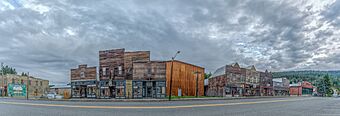
Old storefronts in historic district
|
|
| Location | WA 2E, Roslyn, Washington |
|---|---|
| Area | 340 acres (140 ha) |
| Built | 1890 |
| NRHP reference No. | 78002760 |
| Added to NRHP | February 14, 1978 |
The Roslyn Historic District includes the town of Roslyn as it was in 1977, which is similar to its layout in 1914. It also includes the group of 26 cemeteries southwest of town and a large open space east of town.
Some of the important buildings in the historic district are:
- Roslyn City Hall and Library
- Immaculate Conception Catholic Church
- Northwestern Improvement Company Store
- The Brick Tavern
See also
 In Spanish: Roslyn (Washington) para niños
In Spanish: Roslyn (Washington) para niños


